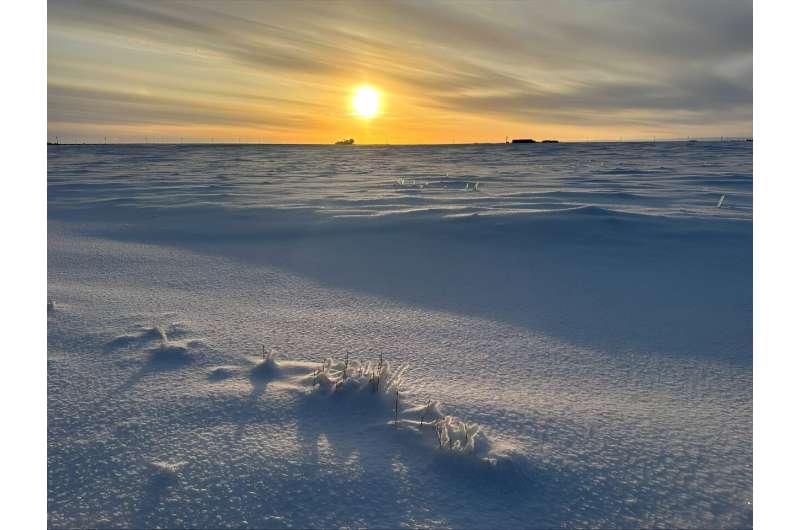This article has been reviewed according to Science X's editorial process and policies. Editors have highlighted the following attributes while ensuring the content's credibility:
fact-checked
peer-reviewed publication
trusted source
proofread
Chasing the light: Study finds new clues about warming in the Arctic

The Arctic, Earth's icy crown, is experiencing a climate crisis like no other. It's heating up at a furious pace—four times faster than the rest of our planet. Sandia researchers are pulling back the curtain on the reduction of sunlight reflectivity, or albedo, which is supercharging the Arctic's warming.
The scientists are not armed with parkas and shovels. Instead, they have tapped into data from GPS satellite radiometers, capturing the sunlight bouncing off the Arctic. This data dive could be the key to cracking the Arctic amplification code.
Their work is published in the journal Scientific Reports.
"The uneven warming in the Arctic is both a scientific curiosity and a pressing concern, leading us to question why this landscape has been changing so dramatically," said Erika Roesler, an atmospheric and climate scientist at Sandia.
Previous studies have suggested that sea-ice albedo feedbacks are likely driving Arctic amplification. These albedo feedbacks can be broken down into two main areas. First, there's an overall reduction in sea ice, leading to more exposure of the dark ocean, which absorbs more sunlight than snow-covered ice—raising temperatures. The second factor is the reflectivity of the remaining sea ice, or local albedo, which includes ponding water on ice due to melting.
Sandia researchers aimed to gain a better understanding of the reduction in reflectivity in the Arctic. Senior scientist Phil Dreike collaborated with the U.S. Space Force to obtain permission for Sandia to analyze previously unpublished data from the radiometers on GPS satellites.
"New observational climate datasets are unique. To qualify as a climate dataset, observations must span a multitude of years. Small-scale science projects are typically not that long in duration, making this dataset particularly valuable," Roesler said.
Amy Kaczmarowski, an engineer at Sandia, conducted an analysis of the data spanning from 2014 to 2019.
"There have been numerous local measurements and theoretical discussions regarding the effects of water puddling on ice albedo. This study represents one of the first comprehensive examinations of year-to-year effects in the Arctic region," Kaczmarowski said.
"Sandia's data analysis revealed a 20% to 35% decrease in total reflectivity over the Arctic summer. According to microwave sea-ice extent measurements collected during the same period, one-third of this loss of reflectivity is attributed to fully melted ice."
The other two-thirds of the loss in reflectivity is likely caused by the weathering of the remaining sea ice. "The key discovery here is just how much the weathered ice is reducing reflectivity," Kaczmarowski added. Weathered ice refers to the remaining sea ice, which can be thinner and may contain melt ponds.
The GPS satellites are expected to continue providing data through 2040. Sandia researchers hope that other researchers will consider their findings and incorporate them into their models for Arctic amplification. They plan to continue mining the GPS data and are enthusiastic about collaborating with other climate researchers for further analysis.
"We will continue to use this data to investigate various regions of the Earth for climate applications," Kaczmarowski said.
More information: Philip L. Dreike et al, Broadband radiometric measurements from GPS satellites reveal summertime Arctic Ocean Albedo decreases more rapidly than sea ice recedes, Scientific Reports (2023). DOI: 10.1038/s41598-023-39877-x
Journal information: Scientific Reports
Provided by Sandia National Laboratories




















